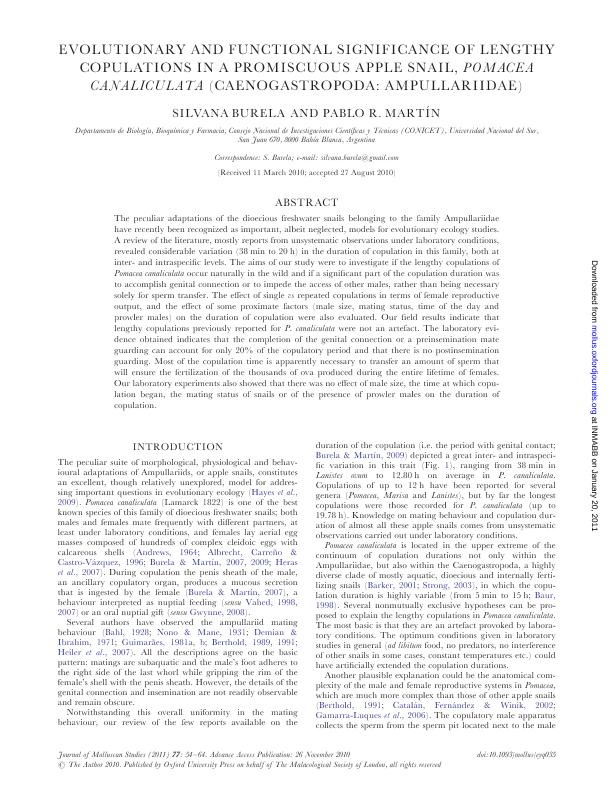Mostrar el registro sencillo del ítem
dc.contributor.author
Burela, Silvana

dc.contributor.author
Martín, Pablo Rafael

dc.date.available
2018-12-26T15:23:29Z
dc.date.issued
2011-02
dc.identifier.citation
Burela, Silvana; Martín, Pablo Rafael; Evolutionary and functional significance of lengthy copulations in a promiscuous apple snail, Pomacea canaliculata (Caenogastropoda: Ampullariidae); Oxford University Press; Journal of Molluscan Studies; 77; 1; 2-2011; 54-64
dc.identifier.issn
0260-1230
dc.identifier.uri
http://hdl.handle.net/11336/66957
dc.description.abstract
The peculiar adaptations of the dioecious freshwater snails belonging to the family Ampullariidae have recently been recognized as important, albeit neglected, models for evolutionary ecology studies. A review of the literature, mostly reports from unsystematic observations under laboratory conditions, revealed considerable variation (38 min to 20 h) in the duration of copulation in this family, both at inter- and intraspecific levels. The aims of our study were to investigate if the lengthy copulations of Pomacea canaliculata occur naturally in the wild and if a significant part of the copulation duration was to accomplish genital connection or to impede the access of other males, rather than being necessary solely for sperm transfer. The effect of single vs repeated copulations in terms of female reproductive output, and the effect of some proximate factors (male size, mating status, time of the day and prowler males) on the duration of copulation were also evaluated. Our field results indicate that lengthy copulations previously reported for P. canaliculata were not an artefact. The laboratory evidence obtained indicates that the completion of the genital connection or a preinsemination mate guarding can account for only 20 of the copulatory period and that there is no postinsemination guarding. Most of the copulation time is apparently necessary to transfer an amount of sperm that will ensure the fertilization of the thousands of ova produced during the entire lifetime of females. Our laboratory experiments also showed that there was no effect of male size, the time at which copulation began, the mating status of snails or of the presence of prowler males on the duration of copulation. © 2010 The Author. Published by Oxford University Press on behalf of The Malacological Society of London, all rights reserved.
dc.format
application/pdf
dc.language.iso
eng
dc.publisher
Oxford University Press

dc.rights
info:eu-repo/semantics/openAccess
dc.rights.uri
https://creativecommons.org/licenses/by-nc-sa/2.5/ar/
dc.subject
Copulation
dc.subject
Mate Guarding
dc.subject
Promiscuity
dc.subject.classification
Otras Ciencias Biológicas

dc.subject.classification
Ciencias Biológicas

dc.subject.classification
CIENCIAS NATURALES Y EXACTAS

dc.title
Evolutionary and functional significance of lengthy copulations in a promiscuous apple snail, Pomacea canaliculata (Caenogastropoda: Ampullariidae)
dc.type
info:eu-repo/semantics/article
dc.type
info:ar-repo/semantics/artículo
dc.type
info:eu-repo/semantics/publishedVersion
dc.date.updated
2018-12-21T15:21:53Z
dc.journal.volume
77
dc.journal.number
1
dc.journal.pagination
54-64
dc.journal.pais
Reino Unido

dc.journal.ciudad
Oxford
dc.description.fil
Fil: Burela, Silvana. Consejo Nacional de Investigaciones Científicas y Técnicas. Centro Científico Tecnológico Conicet - Bahía Blanca; Argentina. Universidad Nacional del Sur. Departamento de Biología, Bioquímica y Farmacia; Argentina
dc.description.fil
Fil: Martín, Pablo Rafael. Consejo Nacional de Investigaciones Científicas y Técnicas. Centro Científico Tecnológico Conicet - Bahía Blanca; Argentina. Universidad Nacional del Sur. Departamento de Biología, Bioquímica y Farmacia; Argentina
dc.journal.title
Journal of Molluscan Studies

dc.relation.alternativeid
info:eu-repo/semantics/altIdentifier/doi/https://doi.org/10.1093/mollus/eyq035
dc.relation.alternativeid
info:eu-repo/semantics/altIdentifier/url/https://academic.oup.com/mollus/article/77/1/54/1187300
Archivos asociados
